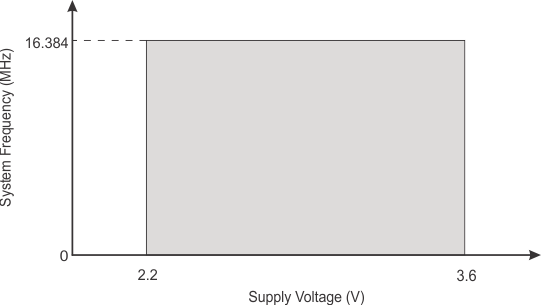SLAS887C September 2014 – March 2021
PRODUCTION DATA
- 1 Features
- 2 Applications
- 3 Description
- 4 Functional Block Diagram
- 5 Revision History
- 6 Device Comparison
- 7 Terminal Configuration and Functions
-
8 Specifications
- 8.1 Absolute Maximum Ratings
- 8.2 ESD Ratings
- 8.3 Recommended Operating Conditions
- 8.4 Active Mode Supply Current (Into VCC) Excluding External Current
- 8.5 Low-Power Mode Supply Currents (Into VCC) Excluding External Current
- 8.6 Thermal Resistance Characteristics
- 8.7
Timing and Switching Characteristics
- 8.7.1 Reset Timing
- 8.7.2 Clock Specifications
- 8.7.3 Wake-up Characteristics
- 8.7.4 I/O Ports
- 8.7.5 Power Management Module
- 8.7.6 Reference Module
- 8.7.7
SD24
- 8.7.7.1 SD24 Power Supply and Recommended Operating Conditions
- 8.7.7.2 SD24 Internal Voltage Reference
- 8.7.7.3 SD24 External Voltage Reference
- 8.7.7.4 SD24 Input Range
- 8.7.7.5 SD24 Performance, Internal Reference (SD24REFS = 1, SD24OSRx = 256)
- 8.7.7.6 SD24 Performance, External Reference (SD24REFS = 0, SD24OSRx = 256)
- 8.7.7.7 Typical Characteristics
- 8.7.8 eUSCI
- 8.7.9 Timer_A
- 8.7.10 Flash
- 8.7.11 Emulation and Debug
- 9 Detailed Description
- 10Applications, Implementation, and Layout
- 11Device and Documentation Support
- 12Mechanical, Packaging, and Orderable Information
Package Options
Mechanical Data (Package|Pins)
Thermal pad, mechanical data (Package|Pins)
Orderable Information
8.3 Recommended Operating Conditions
| MIN | NOM | MAX | UNIT | |||
|---|---|---|---|---|---|---|
| VCC | Supply voltage during program execution and flash programming or erase (VCC = VCC) | 2.2 | 3.6 | V | ||
| VSS | Supply voltage (AVSS = DVSS = VSS) | 0 | V | |||
| TA | Operating free-air temperature | T temperature range | –40 | 105 | °C | |
| TJ | Operating junction temperature | T temperature range | –40 | 105 | °C | |
| CVCORE | Recommended capacitor at VCORE | 470 | nF | |||
| CVCC/ CVCORE |
Capacitor ratio of VCC to VCORE | 10 | ||||
| fSYSTEM | Processor frequency (maximum MCLK frequency) (1) (2) | 0 | 16.384 | MHz | ||
(1) The MSP430i CPU is clocked directly with MCLK.
(2) Modules may have a different maximum input clock specification. See the specification of the respective module in this data
sheet.
 Figure 8-1 Maximum System Frequency
Figure 8-1 Maximum System Frequency